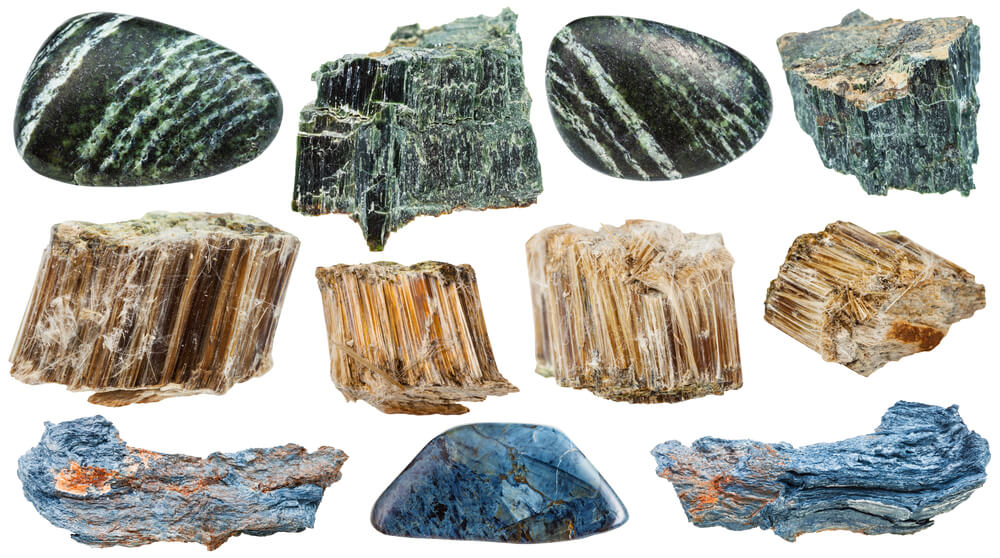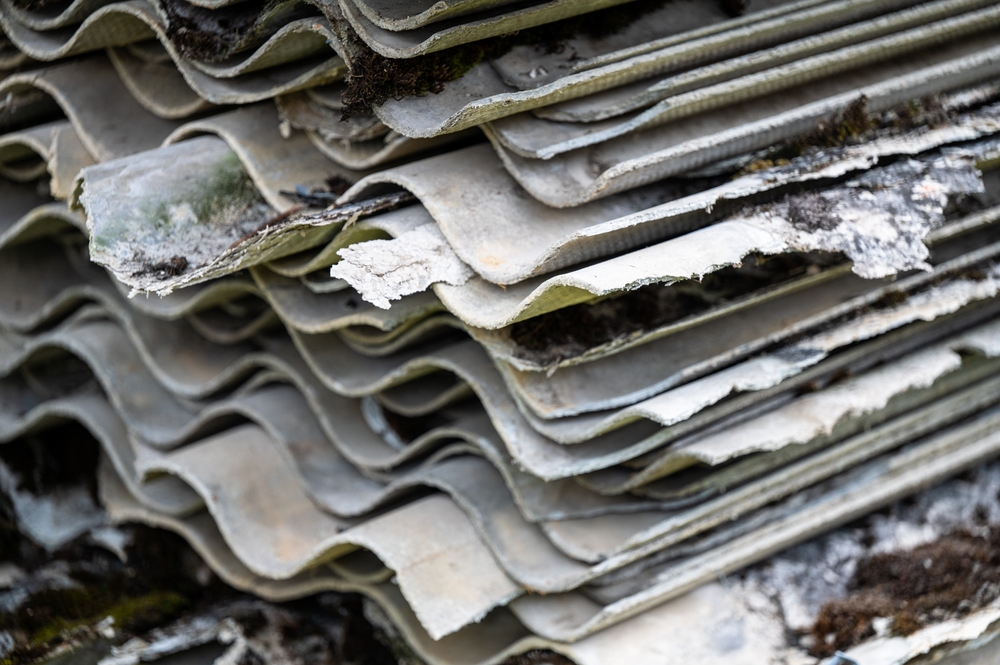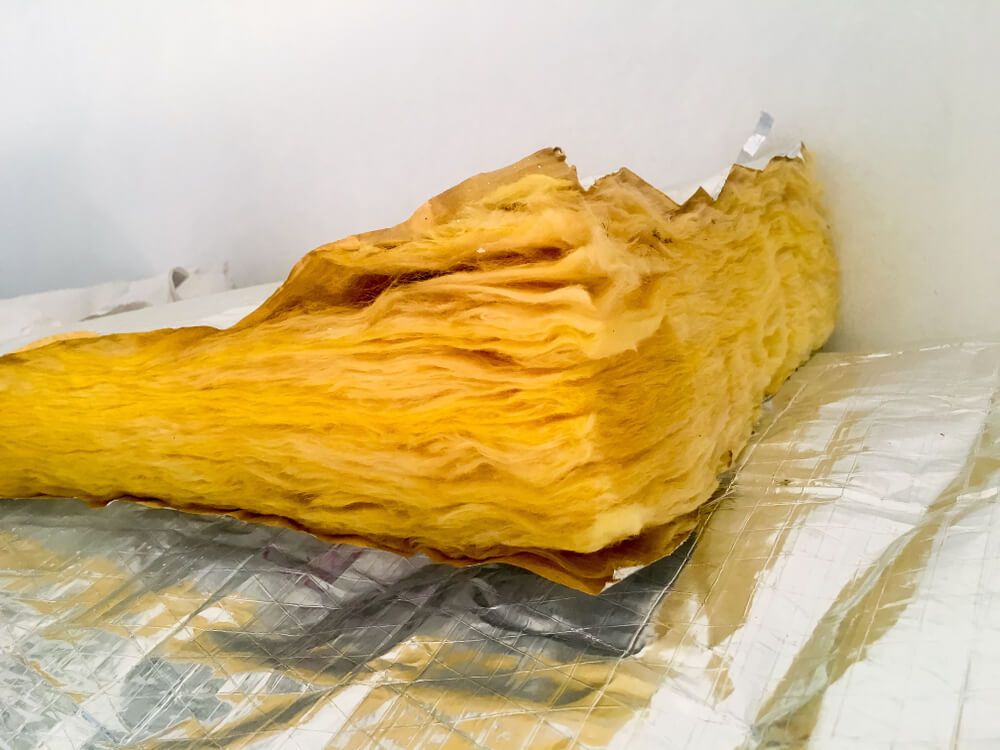
Asbestos can be tough to identify, often blending with common materials. If you’re wondering ‘what does asbestos look like’? It varies widely: white, blue, brown, or grey, in forms like fibres or solid sheets. In this article, we’ll aim to help you understand where asbestos could be in your home and how you may be able to identify it.
Before we dive right in, it’s important to recognise that often it’s difficult to accurately identify asbestos. This can be because it is often mixed with other products or because the asbestos fibres are very small in size. If you suspect that asbestos is present on your property, you should seek help from professional asbestos experts.
Raw asbestos is like a wolf in sheep’s clothing—deceptively harmless in appearance but deadly when disturbed. In its natural state, asbestos appears loose and fluffy, with colours ranging from grey and grey-brown to grey-blue. When processed, it breaks down into fine, fluffy fibres that are incredibly dangerous if inhaled. The three main types of asbestos fibres are:

Each type has unique characteristics.
The importance of understanding these types lies in the fact that asbestos fibres are linked to several severe health issues, including asbestos related diseases such as asbestosis, lung cancer, and mesothelioma. Friable asbestos, which crumbles easily when disturbed, poses a higher risk as it can release harmful asbestos fibres into the air. Therefore, professional identification is paramount to prevent health risks and potential legal consequences.
The first step in protecting your environment from the hidden dangers of asbestos lies in recognising raw asbestos.
The 1900s saw widespread use of asbestos in building materials due to its fire resistance and fibre strength. From insulation to cement products, asbestos was the go-to material for enhancing durability and safety. However, these asbestos-containing materials (ACMs) now pose significant health risks. Professional asbestos testing is required to identify asbestos in these materials since many resemble non-asbestos materials.
Asbestos can be found in various materials, including:
These materials are just a few examples of where asbestos might be lurking in your home or workplace, highlighting the importance of professional identification and testing.

Asbestos Insulating Board is a common culprit in older buildings. Typically containing amosite (brown asbestos), it can range from light to dark grey in colour. Its medium to soft density makes it easily damaged, which significantly increases the risk of asbestos fibre release. This material was widely used in:
Given its widespread use and high risk of fibre release, it is imperative to identify and safely manage it. Whether in your walls for fire protection or as part of your ceiling structure, AIB is one of the many asbestos-containing materials that require careful attention and professional handling.

Asbestos cement products, such as sheets, pipes, and asbestos cement flues, typically contain 10-25% asbestos and are known for their light to dark grey colour. These materials are thin, rigid, weatherproof, and heat resistant, making them ideal for various applications. Asbestos cement pipes, also known as transit pipes, were commonly used for potable drinking water distribution, sewer drains, and storm drains due to their high density and low potential for fibre release.
Despite their durability, the presence of asbestos in these products poses significant health risks. It is important to identify asbestos cement products in your building, particularly those showing signs of wear or damage, as this could lead to asbestos fibre release.

Asbestos textiles and cloth are typically white and can contain nearly 100% asbestos. These materials were used for their excellent asbestos thermal insulation properties in applications such as fire blankets and flues. The appearance of asbestos textiles includes forms like rope, gasket, and blanket, each designed for specific insulation needs.
Given their high asbestos content, these textiles pose a significant risk if disturbed due to the potential release of asbestos fibres. To prevent asbestos fibre release and ensure safety, proper identification and handling are required.

Flooring materials are another common source of asbestos in older buildings. Asbestos was often used in older linoleum and sheet vinyl flooring, as well as in the adhesives for installing these materials. The presence of asbestos in flooring adhesives is particularly concerning because it can be easily disturbed during renovations.
Many older homes may still contain asbestos in their flooring materials, hence the need for professional asbestos testing before initiating any renovation projects. This ensures that harmful asbestos fibres are not inadvertently released during the process.
Asbestos-containing asbestos floor tiles were widely used in high-wear areas such as:
These tiles often appear in multiple colours and patterns, making them visually versatile. They are usually thicker and harder compared to modern vinyl tiles, which helps in identifying them.
Despite their durability, the presence of asbestos in these tiles poses significant health risks if disturbed. To prevent the release of asbestos fibres, proper identification and handling are necessary.
Carpet underlay is another unsuspecting source of asbestos in older homes. Asbestos carpet underlay was used to provide additional insulation and fire resistance. This material often appears dark and fibrous, and the adhesive used to glue it down may also contain asbestos, usually in the form of a black bituminous material.
To prevent exposure during carpet replacement or renovation projects, it’s necessary to identify asbestos in carpet underlay and its adhesive. Professional testing and removal are recommended to ensure safety.

Asbestos can also be found in ceilings and walls, posing a hidden threat in many older buildings. Asbestos ceiling tiles are often light-coloured, slightly textured, and powdery white with small dotted indentations. Deteriorating or damaged ceiling tiles can release asbestos fibres into the air, posing significant health risks.
Wall insulation is another common source of asbestos. Asbestos-containing wall insulation can resemble:
Professional testing is required to identify these materials, given the challenge in distinguishing them from non-asbestos materials.
Popcorn ceilings, popular from the 1950s to the 1980s, often contain asbestos. These ceilings have a rough and bumpy texture, achieved using vermiculite or polystyrene, which may contain asbestos. The bumpy, textured surface of asbestos-containing popcorn ceilings is usually white or off-white.
Detecting asbestos in popcorn ceilings is difficult because the fibres are microscopic, making visual identification nearly impossible. Professional testing is the only reliable method to confirm the presence of asbestos in these ceilings.
Asbestos-containing wall insulation often appears as fibrous material, making it hard to identify without professional testing. This insulation can be found in older buildings, particularly those built before the 1980s. Wall insulation containing asbestos can have various colours and finishes and may contain all types of asbestos fibres.
The fibrous nature of asbestos wall insulation poses a significant health risk if disturbed. To ensure safety, professional testing and handling are necessary.

Pipe insulation and gaskets are other common sources of asbestos in older buildings. Asbestos was commonly used in pipe insulation, often referred to as lagging or pipe wrapping. This asbestos insulation could appear fluffy, smooth, or lumpy, resembling dried cement or built-up dust. Prefabricated asbestos pipe wrap typically looked like white corrugated cardboard.
Asbestos gaskets and washers generally contain up to 90% asbestos and were used to create airtight and watertight seals. The gasket material is usually friable, meaning it can easily crumble and release asbestos fibres into the air. To prevent exposure, these materials need to be properly identified and handled.
Loose fill insulation, such as vermiculite, is another common source of asbestos in older buildings. Vermiculite insulation with asbestos typically appears as greyish, brown, or silvery-gold rocky gravel. This material is usually poured into wall cavities and can contain asbestos fibres.
Asbestos dust from asbestos loose fill insulation poses significant health risks, including asbestosis, lung cancer, and mesothelioma. To prevent asbestos fibre release and ensure safety, it is necessary to identify and safely handle this type of insulation.

Asbestos can also be found in electrical components, posing a hidden threat in older buildings. Electrical backing boards, such as asbestos resin boards (zelemite) and fibre cement sheets, often contain asbestos. Bituminous electrical backing boards are black panels fixed to walls or electrical switch boxes, often emitting a strong smell of bitumen or tar.
These backing boards, commonly found in electrical substations, can release asbestos dust, posing significant health risks. To prevent exposure, it’s necessary to identify and safely handle asbestos-containing electrical components.
For safety, it’s important to be aware of the asbestos materials in your home, including their locations and current condition. The Environmental Protection Agency (EPA) advises treating all vermiculite products as if they contain asbestos due to the high risk. If you suspect asbestos, hire a certified professional for testing and removal.
Do-it-yourself asbestos testing kits can be hazardous if not handled properly, so it is best to engage a licensed asbestos professional. They can provide asbestos air monitoring and clearance inspections, ensuring that the removal process is safe and thorough.
Before any home renovation, asbestos testing is essential to prevent the release of hazardous asbestos fibres. Testing should be conducted in any property built before 1985 prior to renovations or demolitions. Professional asbestos testing can help identify the presence and type of asbestos fibres in a building, ensuring that appropriate measures are taken to handle them safely.

Understanding the appearance and risks of asbestos is crucial for ensuring the safety of your home or workplace. From raw asbestos to its presence in building materials, flooring, ceilings, walls, pipe insulation, and electrical components, being informed is your first line of defince. Always engage professional asbestos experts like us here at Asbestos Australia for identifying, testing and removal to prevent asbestos exposure and protect your health. Take action now to ensure a safe environment for you and your loved ones.
To determine if your ceiling tiles contain asbestos, look for light-coloured, slightly textured, powdery white tiles with small dotted indentations. However, professional testing is necessary to confirm the presence of asbestos.
Asbestos-containing vinyl floor tiles often appear in multiple colours and patterns and are usually thicker and harder compared to modern vinyl tiles. Be cautious of tiles with these characteristics.
No, it is not safe to remove asbestos yourself. It is highly recommended to hire a certified professional for asbestos removal to ensure safe and thorough removal.
If you suspect asbestos in your home, avoid disturbing the material and seek help from a certified professional for testing and removal, as advised by the EPA. It’s important to treat all vermiculite products as if they contain asbestos due to the high risk.
Posted By: Asbestos Australia Removalist
Leave a Reply